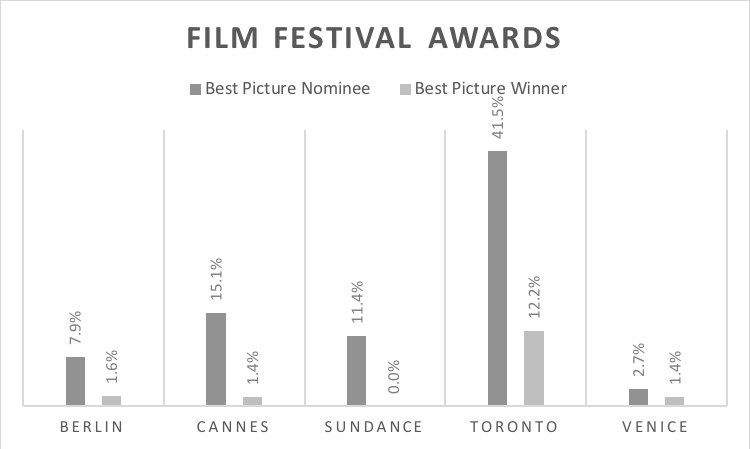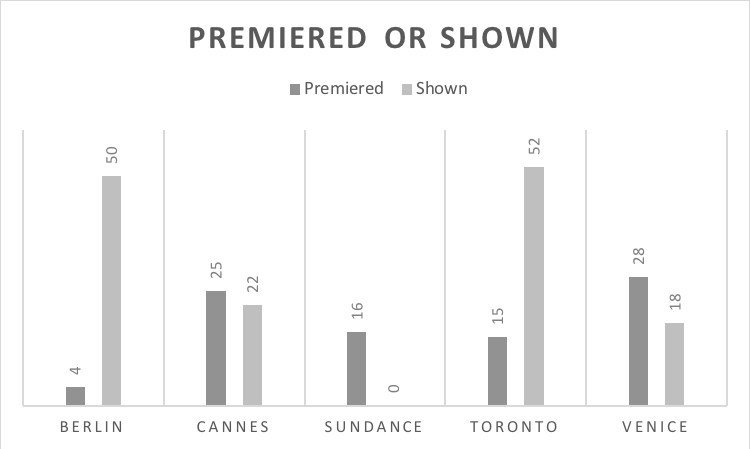A study conducted as part of a School of Communication research course at Emerson College assessed the predictive value of five of the major film festivals for the Academy Award for Best Picture. They included the Berlin International Film Festival, the Cannes Film Festival, the Sundance Film Festival, the Toronto International Film Festival and the Venice Film Festival.
The study found that the Toronto International Film Festival’s People’s Choice Award was by far the best indicator of success. Specifically, the research revealed that 41.5% of the People’s Choice Award winners were nominated for Best Picture and that 12.2% won for Best Picture. By comparison, the percentage of Best Picture nominees among other film festival award winners were the Cannes Film Festival at 15.1%, the Sundance Film Festival at 11.4%, the Berlin International Film Festival at 7.9% and the Venice Film Festival at 2.7%. In addition, the Sundance winner has never been a Best Picture winner while the Berlin, Cannes and Venice film festivals all had similar percentages at 1.6%, 1.4% and 1.4%, respectively (see Exhibit 1).

Exhibit 1
The People’s Choice Award is determined by thousands of audience members who attend the Toronto festival which is in stark contrast to the expert juries that decide the primary awards for the other festivals. The researchers found that the difference between these results was most likely due to the different missions, programs and processes of the festivals. However, they also found that Toronto’s results were also likely evidence of the wisdom of crowds. This concept was popularized by James Surowiecki in his 2004 book, The Wisdom of Crowds, and argues that large groups of people are collectively smarter than individual experts when it comes to problem solving, decision making, innovating and predicting.
The Hamptons International Film Festival was also evaluated because it includes both a jury and audience award for Best Narrative Feature. Since the festival’s founding in 1993, none of the jury awards have been nominated for Best Picture, whereas 22.2% of the audience awards have been nominated including 77.8% of them in the last nine years.
As an aside, the Sundance Film Festival also offers an audience award but these awards were found to be less predictive than its jury award. This was believed to be the result of the unique mission of the Sundance festival which is to promote independent films and artists whereas Toronto’s mission is “to transform the way people see the world through film.” That said, Sundance has been extremely influential in launching successful films and careers and, like the other festivals, is true to its mission.
In addition, researchers explored the extent to which these festivals were used as a platform to promote these films. To that end, they discovered that many films either premiered or were shown at these festivals despite their predictive ability (see Exhibit 2).

Exhibit 2
“These findings provide another example of how large groups of people can make better decisions than small groups of experts under the right conditions which include diversity, independence and decentralization,” said Owen Eagan, an Executive-in-Residence in the Department of Communication Studies. “Therefore, this helps us understand why some film festivals have more predictive value than others while considering their unique characteristics.”
Researchers found that these results were similar to the collective opinions used by prediction markets such as the Hollywood Stock Exchange (HSX), which has been known to be an accurate predictor of movie outcomes. The HSX allows users to wager simulated money on the box office performance of films as well as Oscar nominees and winners.





